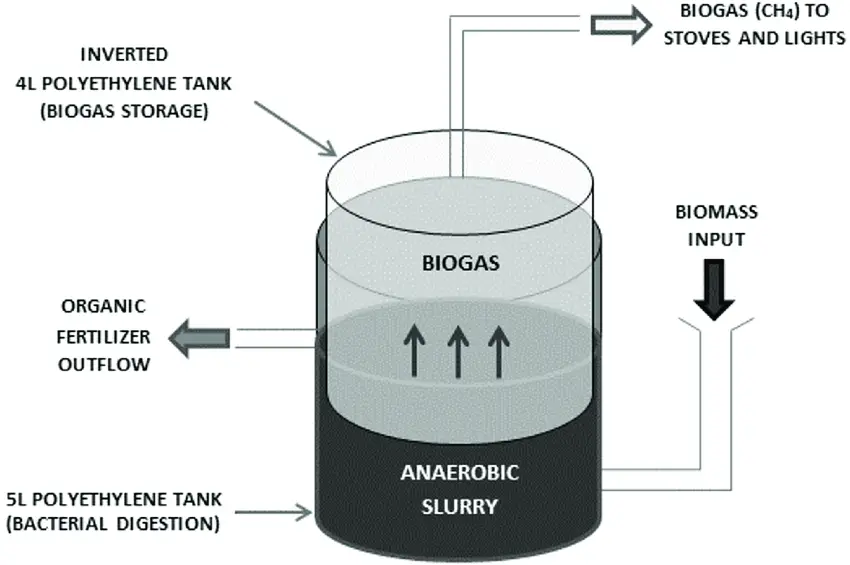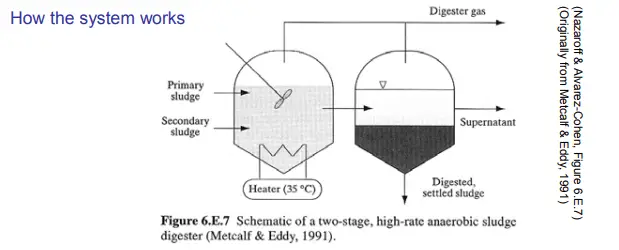Anaerobic Wastewater Treatment For More Renewable Energy
The Ability to Turn Sewage Sludge to Energy and Fertilizers!

Anaerobic Treatment commonly referred to as Anaerobic digestion is an energy-efficient environmentally friendly technology. It is one of the two technologies we commonly use for wastewater treatment. The other method used is aerobic digestion.
We are currently using this method as one of the first areas of wastewater treatment.
It has become more popular since it can help us stabilize the water while creating low levels of biomass production.
Wastewater Treatment System
Anaerobic digestion uses microorganisms in an oxygen-deprived environment to break down organic material in the wastewater into reusable biogas.
The reactors are enclosed to be airtight, preventing any air into the unit. Being airtight also helps to avoid any smells from leaking out.
This airtight seal also allows Anaerobic bacteria to live and grow since they cannot survive in oxygen.
Anaerobic wastewater treatment systems get used mostly on wastewater(sludges), food production, and municipal sewage treatment systems.
Any organic compounds that contain high concentrations of biodegradable organic matter(Specifically high in soluble BOD and/or COD) can get used.
The process will degrade the complex molecules in the wastewater to simpler compounds.
Anaerobic digestion also offers several benefits over the Aerobic treatment.
Since it has lower energy requirements, requires fewer chemicals, and results in a lower production of sludge[1].
Anaerobic Wastewater Treatment Methods
A one or two-tank system can get used.
Many companies prefer to use a two-tank system since it gives them more precise control over the digestion process.
In the first phase of a two-tank system, a tank with a continual mixer needs to get used.
In this first tank, all of the sludge flows get combined and mildly heated to help accelerate biological conversion. The product stays in the first stage for 10 to 20 days.
The second tank further digestion and biogas collection can happen. Continual mixing of the sludge is no longer required.
Now, the settled sludge from the second tank gets dewatered thickening the sludge. The facility will then separate as much water as it can to decrease the pile of sludge.
Finally, it will go through the process of stabilization to reduce the total number of pathogens it contains.
In single-tank digestors, the mixing happens intermittently. The sludge in this system has a slower digestion rate, so the wastewater needs to get housed in the tank for a more prolonged period (around 30 to 60 days[5]).
Anaerobic Digestion Wastewater Treatment Design

Anaerobic Digestion Wastewater Treatment Systems
There are two primary anaerobic systems in use.
The first and easiest is the batch system. All of the organic material gets added at one time. Batch systems may only use a one tank system design.
The other is a continuous system. As the name suggests, the organic solution gets continually added. This method usually uses the two-tank system.
Continual feeding allows maximum levels of biogas collection but generally requires constant monitoring and removal of biomass sludge.
4 Stages of Anaerobic Digestion
-
1) hydrolysis
Basically, it is the chemical breakdown of a compound due to the reaction with water.
Biomass is generally made up of what is referred to as natural polymers. Being a polymer means that it has a molecular structure with a large number of similar units bonded together.
hydrolysis allows the wastewater to break down the organic chains and dissolve them into simple sugars, amino acids, and fatty acids.
The Acetate and hydrogen produced in this step can get used by what scientist call methanogens(microorganisms that produce methane) to start producing methane gas immediately.
-
2) Acidogenesis
The second stage in the anaerobic digestion is acidogenesis.
The remaining components will get broken down further by fermentative bacteria. In this stage, VFAs(Volatile fatty acids), ammonia, carbon dioxide, and hydrogen sulfide get created.
-
3) Acetogenesis
The third stage in the anaerobic digestion is acetogenesis.
Acetogenesis will convert the volatile fatty acids, acetic acid, carbon dioxide, and hydrogen through a biological reaction into acetic acid.
The species of bacteria used for this part of the process get called acetogenins.
You are probably already familiar with acetic acid since vinegar is mostly just diluted acetic acid.
-
4) Methanogenesis.
The fourth and final stage of anaerobic digestion is a biological process called methanogenesis.
Microorganisms called methanogens use the by-product from stage 3 and convert them into methane, carbon dioxide, and water.
These three products make up the majority of biogas that gets emitted from the system.
Water Treatment Anaerobic Conditions
The pH of the sludge must also get maintained. If the pH levels drop below a pH of 6.2, it will inhibit microbial growth rate[6].
Anaerobic Wastewater Treatment Temperature
For Anaerobic Digestion of water waste, the solution will get heated between 20°C up to 45, and some systems will even use temperatures of up to 75°C[3][4].
Higher temperatures allow more of the biogas to get released in a shorter period.
Anaerobic Wastewater Treatment Advantages
while bacteria are feeding off of the biodegradable material biogas is getting created.
The gas created is a mixture of approximately 60% methane and 40% carbon dioxide.
We can collect this gas and reuse it to generate heat and electricity. Biofuel helps us to reduce the number of fossil fuels we are burning.
It has a minimal carbon footprint.
Many operations use this electricity to feedback into the system to keep the digester within the optimal temperature range. This helps us to reduce our operating costs.
The leftover biomaterial is a nutrient-rich slurry. With further processing, the leftover nutrient-rich sludge can get used in soil to help improve the nutrient levels.
Anaerobic digestion produces digestate, a nutrient-rich slurry. Digestate can be applied to agricultural land as a fertilizer and/or soil amendment to improve soil health. Digestate that is applied to land is subject to both state and federal regulations.
Anaerobic Wastewater Treatment Disadvantages
If the nutrient-rich sludge gets improperly disposed of in rivers or ponds, it will quickly create algae overgrowth.
Overgrowth of algae in our waters can kill fish and other aquatic life.
The anaerobic process is much slower than using aerobic digestion. It is also less efficient since it attacks a much smaller range of microbes.
The pH needs to get maintained to make sure microbial growth does not get inhibited.
If there is any ammonia-nitrogen in the wastewater, it may not get removed with this process.
Conclusion
Treating the sludge instead of sending it to landfills helps us to reduce the methane gas getting released in our landfills.
The ability to use the leftover bioproducts in the creating of natural fertilizers could help to reduce the number of chemicals needed in our agriculture sector.
I like that it does not require chemicals like our other wastewater processing method.
These natural fertilizers can help us to increase the nutritional soil value while reducing wastewater contaminants at the same time.
If we install enough of these systems, it could also help us reduce our reliance on corn for the creation and collection of biofuels.
The less land use we need for creating renewable products, the more landmass countries can keep for feeding the population.
[1]ANAEROBIC VS. AEROBIC TREATMENT: WEIGHING WASTEWATER TREATMENT OPTIONS - https://www.evoqua.com/en/brands/adi-systems/Pages/Anaerobic-vs-Aerobic-Treatment.aspx
[2]Anaerobic Treatment - https://www.sciencedirect.com/topics/earth-and-planetary-sciences/anaerobic-treatment
[3]Environmental Benefits of Anaerobic Digestion (AD) - https://www.epa.gov/anaerobic-digestion/environmental-benefits-anaerobic-digestion-ad
[4]Thermophilic Anaerobic Wastewater Treatment; - Temperature Aspects and Process Stability - http://edepot.wur.nl/200091
[5]Anaerobic Sludge Digestion - https://chokhavatia.com/skills/treatment-processes/anaerobic-sludge-digestion/
[6]The effect of temperature and retention time on methane production and microbial community composition in staged anaerobic digesters fed with food waste - https://biotechnologyforbiofuels.biomedcentral.com/articles/10.1186/s13068-017-0989-4
[7]BIOMASS Sewage Sludge to Energy http://bio-organic.com/wp-content/uploads/2014/12/Ridgewood-NJ-Renewable-Energy.pdf